Comprehensive Data Analysis: Statistical Interpretation and Insights
VerifiedAdded on 2023/06/12
|15
|2540
|111
Report
AI Summary
This report provides a comprehensive analysis of data using various statistical methods. It includes computations of mean, standard deviation, variance, and correlation coefficients. The report differentiates between time series and cross-sectional data, constructs a network diagram for project management, and identifies the critical path. Furthermore, it examines regression equations, coefficients of determination, and performs break-even analysis. The analysis includes a reflective learning section, detailing the skills gained and areas for improvement. The high-low method is used to compute variable costs and fixed costs, and the margin of safety is calculated. The report concludes with an analysis of the computations, providing insights into sales targets and break-even points.

UNDERSTANDING
AND MANAGING
DATA
AND MANAGING
DATA
Paraphrase This Document
Need a fresh take? Get an instant paraphrase of this document with our AI Paraphraser

Table of Contents
PART 1............................................................................................................................................4
TASK 1............................................................................................................................................4
(b) Analyse and interpret standard deviation and mean.........................................................4
TASK 2............................................................................................................................................4
(b) State the reason behind mean and standard deviation of grouped data and ungrouped data.
Which one is more accurate?..................................................................................................6
(c) Comment on the least amount spent by the customer on the top 25% by the customers. 6
TASK 3............................................................................................................................................6
Differentiate between the time series data and cross sectional data according to the lifestyle
and demographic profile nature of the customers..................................................................6
TASK4.............................................................................................................................................7
(a) Construct network diagram that shows movement of backward and forward data..........7
(b) Identify critical path and time period of the project.......................................................10
(c) Differentiate between non- critical and critical activities...............................................10
TASK 5..........................................................................................................................................10
(a) Work out the coefficient between total cost and quarterly sales and average order value
and gross profit. Make a correlation matrix.........................................................................10
(b) Determine appropriate forecaster of sales and also explain the reason behind it...........11
(c) Draw a scatter diagram and also show a trend of regression equation...........................11
(d) Examine the determination and coefficient of correlation..............................................11
(e) Examine the equation of regression and examine the value...........................................11
TASK 6..........................................................................................................................................12
1. Work out the coefficient of fluctuations for organisation A and B..................................12
2. By Assuming the risk of retailers is negative, name the project which should be selected
from the available projects...................................................................................................12
TASK 7..........................................................................................................................................12
Reflective learning gained through the project....................................................................12
PART 2..........................................................................................................................................13
1. Compute variable cost with the help of high-low method...............................................13
PART 1............................................................................................................................................4
TASK 1............................................................................................................................................4
(b) Analyse and interpret standard deviation and mean.........................................................4
TASK 2............................................................................................................................................4
(b) State the reason behind mean and standard deviation of grouped data and ungrouped data.
Which one is more accurate?..................................................................................................6
(c) Comment on the least amount spent by the customer on the top 25% by the customers. 6
TASK 3............................................................................................................................................6
Differentiate between the time series data and cross sectional data according to the lifestyle
and demographic profile nature of the customers..................................................................6
TASK4.............................................................................................................................................7
(a) Construct network diagram that shows movement of backward and forward data..........7
(b) Identify critical path and time period of the project.......................................................10
(c) Differentiate between non- critical and critical activities...............................................10
TASK 5..........................................................................................................................................10
(a) Work out the coefficient between total cost and quarterly sales and average order value
and gross profit. Make a correlation matrix.........................................................................10
(b) Determine appropriate forecaster of sales and also explain the reason behind it...........11
(c) Draw a scatter diagram and also show a trend of regression equation...........................11
(d) Examine the determination and coefficient of correlation..............................................11
(e) Examine the equation of regression and examine the value...........................................11
TASK 6..........................................................................................................................................12
1. Work out the coefficient of fluctuations for organisation A and B..................................12
2. By Assuming the risk of retailers is negative, name the project which should be selected
from the available projects...................................................................................................12
TASK 7..........................................................................................................................................12
Reflective learning gained through the project....................................................................12
PART 2..........................................................................................................................................13
1. Compute variable cost with the help of high-low method...............................................13
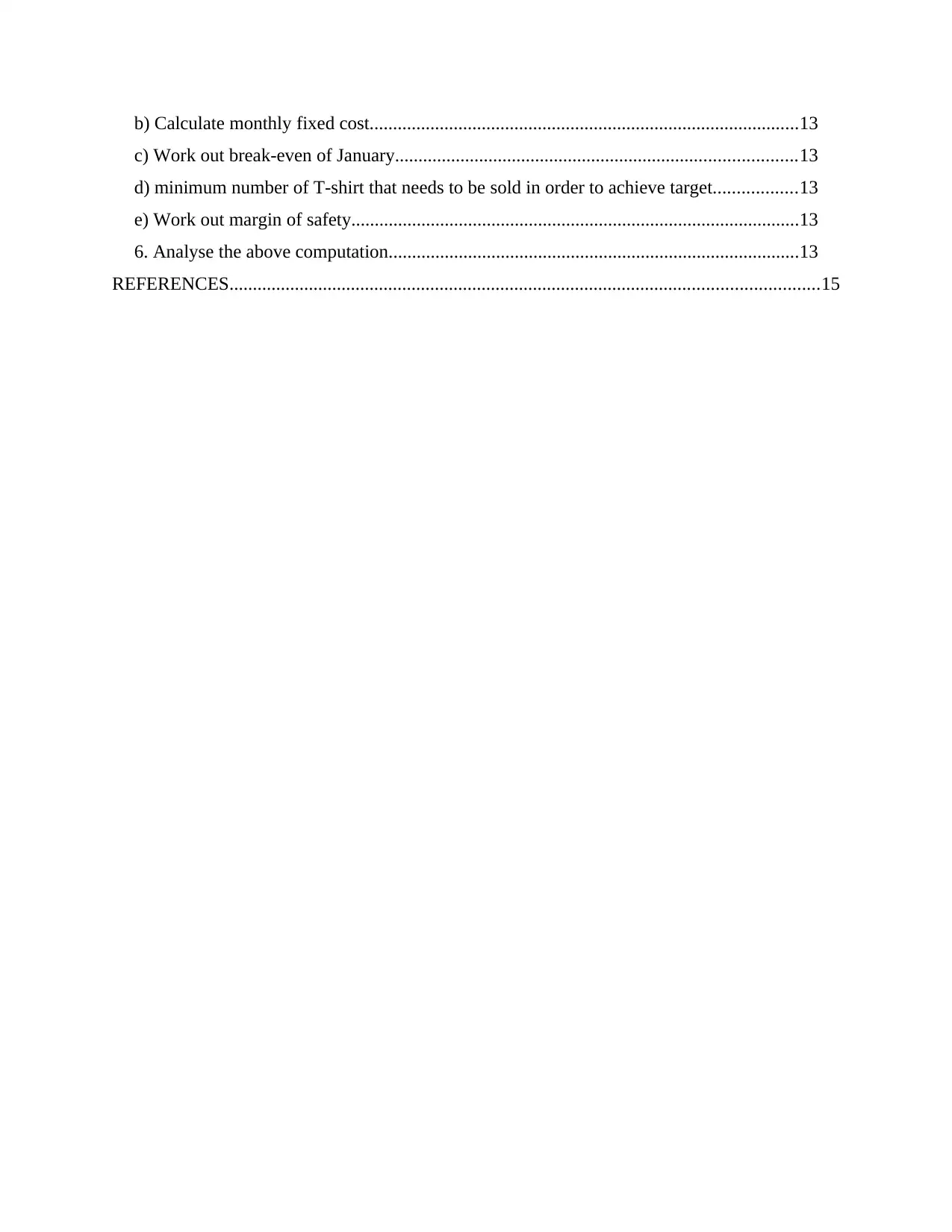
b) Calculate monthly fixed cost............................................................................................13
c) Work out break-even of January......................................................................................13
d) minimum number of T-shirt that needs to be sold in order to achieve target..................13
e) Work out margin of safety................................................................................................13
6. Analyse the above computation........................................................................................13
REFERENCES..............................................................................................................................15
c) Work out break-even of January......................................................................................13
d) minimum number of T-shirt that needs to be sold in order to achieve target..................13
e) Work out margin of safety................................................................................................13
6. Analyse the above computation........................................................................................13
REFERENCES..............................................................................................................................15
⊘ This is a preview!⊘
Do you want full access?
Subscribe today to unlock all pages.

Trusted by 1+ million students worldwide

PART 1
TASK 1
(a) Compute the sum and variance in excel.
Expenditure (£) on
Stand Mixers
Mean 224.00
Standard Error 6.58
Median 224.00
Mode 224.00
Standard Deviation 75.00
Sample Variance 5625.00
Kurtosis -0.49
Skewness -0.32
Range 301.00
Minimum 68.00
Maximum 369.00
Sum 29120.00
Count 130.00
Coefficient of Variation 33.5%
(b) Analyse and interpret standard deviation and mean.
The above data states that the central average of the data is 224 and 75 is the standard
deviation. Standard deviation states the difference of the observation from the mean. In the
following case its highly fluctuated from the mean (Cauley, 2021).
TASK 2
(a) Make table in excel and attach it in the report by including the value given.
Table 1
TASK 1
(a) Compute the sum and variance in excel.
Expenditure (£) on
Stand Mixers
Mean 224.00
Standard Error 6.58
Median 224.00
Mode 224.00
Standard Deviation 75.00
Sample Variance 5625.00
Kurtosis -0.49
Skewness -0.32
Range 301.00
Minimum 68.00
Maximum 369.00
Sum 29120.00
Count 130.00
Coefficient of Variation 33.5%
(b) Analyse and interpret standard deviation and mean.
The above data states that the central average of the data is 224 and 75 is the standard
deviation. Standard deviation states the difference of the observation from the mean. In the
following case its highly fluctuated from the mean (Cauley, 2021).
TASK 2
(a) Make table in excel and attach it in the report by including the value given.
Table 1
Paraphrase This Document
Need a fresh take? Get an instant paraphrase of this document with our AI Paraphraser
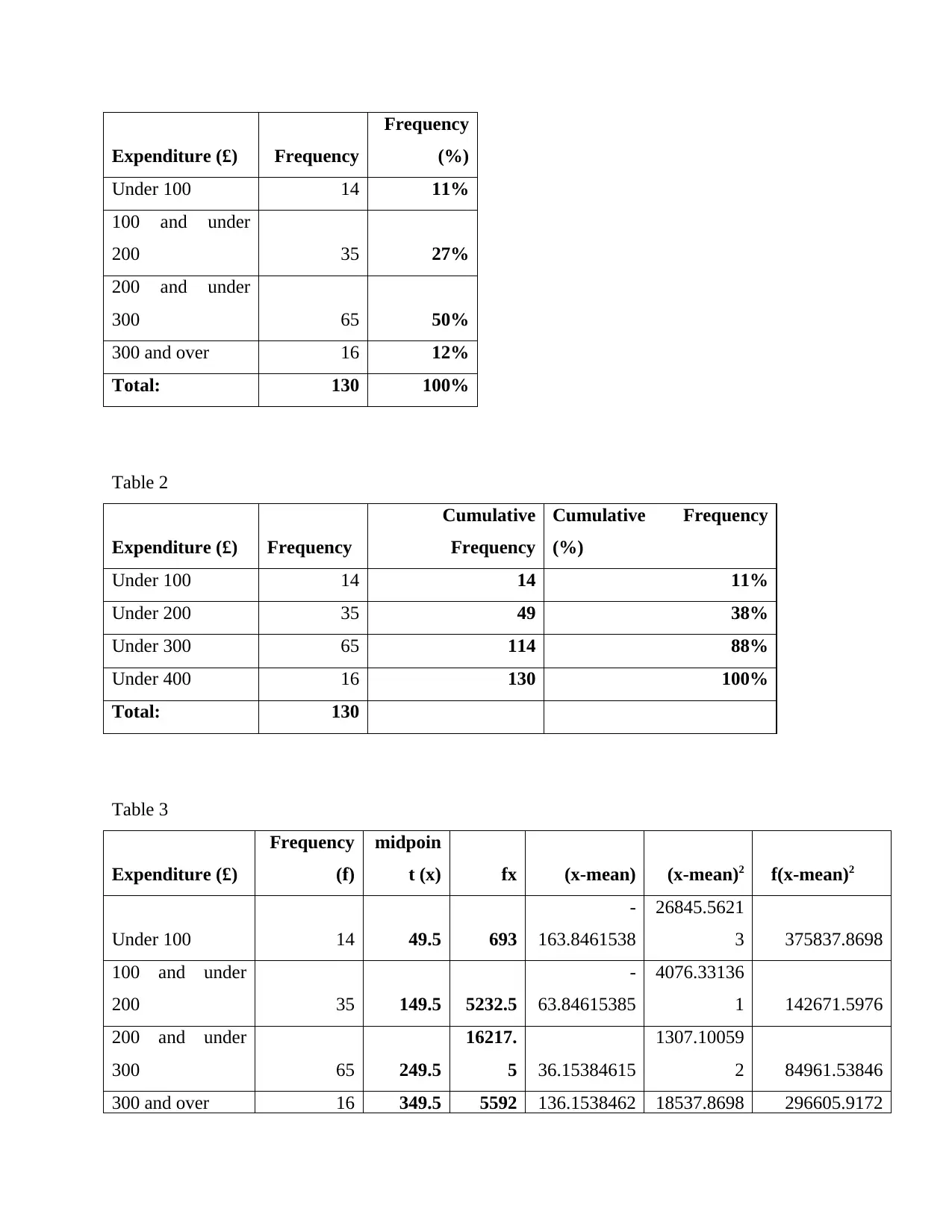
Expenditure (£) Frequency
Frequency
(%)
Under 100 14 11%
100 and under
200 35 27%
200 and under
300 65 50%
300 and over 16 12%
Total: 130 100%
Table 2
Expenditure (£) Frequency
Cumulative
Frequency
Cumulative Frequency
(%)
Under 100 14 14 11%
Under 200 35 49 38%
Under 300 65 114 88%
Under 400 16 130 100%
Total: 130
Table 3
Expenditure (£)
Frequency
(f)
midpoin
t (x) fx (x-mean) (x-mean)2 f(x-mean)2
Under 100 14 49.5 693
-
163.8461538
26845.5621
3 375837.8698
100 and under
200 35 149.5 5232.5
-
63.84615385
4076.33136
1 142671.5976
200 and under
300 65 249.5
16217.
5 36.15384615
1307.10059
2 84961.53846
300 and over 16 349.5 5592 136.1538462 18537.8698 296605.9172
Frequency
(%)
Under 100 14 11%
100 and under
200 35 27%
200 and under
300 65 50%
300 and over 16 12%
Total: 130 100%
Table 2
Expenditure (£) Frequency
Cumulative
Frequency
Cumulative Frequency
(%)
Under 100 14 14 11%
Under 200 35 49 38%
Under 300 65 114 88%
Under 400 16 130 100%
Total: 130
Table 3
Expenditure (£)
Frequency
(f)
midpoin
t (x) fx (x-mean) (x-mean)2 f(x-mean)2
Under 100 14 49.5 693
-
163.8461538
26845.5621
3 375837.8698
100 and under
200 35 149.5 5232.5
-
63.84615385
4076.33136
1 142671.5976
200 and under
300 65 249.5
16217.
5 36.15384615
1307.10059
2 84961.53846
300 and over 16 349.5 5592 136.1538462 18537.8698 296605.9172
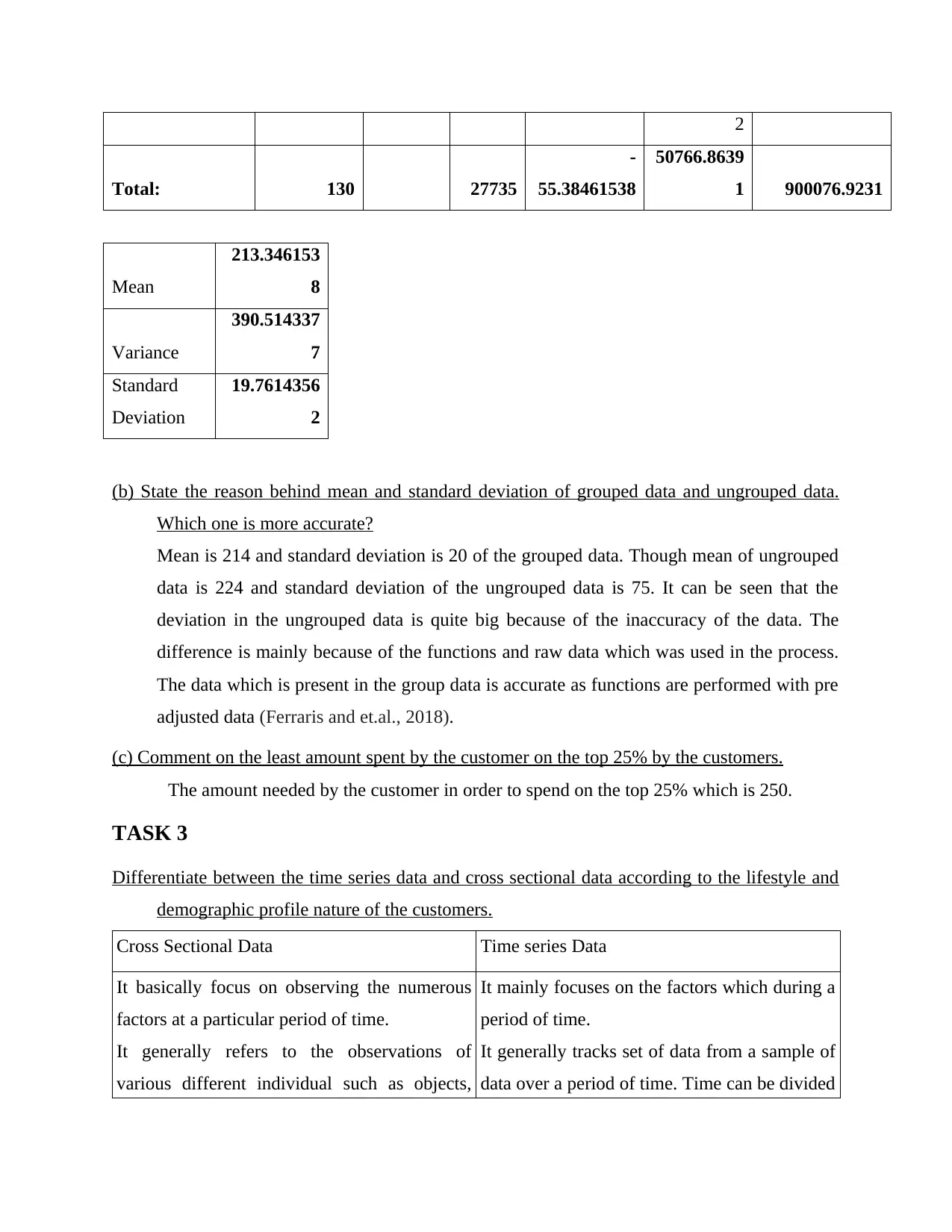
2
Total: 130 27735
-
55.38461538
50766.8639
1 900076.9231
Mean
213.346153
8
Variance
390.514337
7
Standard
Deviation
19.7614356
2
(b) State the reason behind mean and standard deviation of grouped data and ungrouped data.
Which one is more accurate?
Mean is 214 and standard deviation is 20 of the grouped data. Though mean of ungrouped
data is 224 and standard deviation of the ungrouped data is 75. It can be seen that the
deviation in the ungrouped data is quite big because of the inaccuracy of the data. The
difference is mainly because of the functions and raw data which was used in the process.
The data which is present in the group data is accurate as functions are performed with pre
adjusted data (Ferraris and et.al., 2018).
(c) Comment on the least amount spent by the customer on the top 25% by the customers.
The amount needed by the customer in order to spend on the top 25% which is 250.
TASK 3
Differentiate between the time series data and cross sectional data according to the lifestyle and
demographic profile nature of the customers.
Cross Sectional Data Time series Data
It basically focus on observing the numerous
factors at a particular period of time.
It generally refers to the observations of
various different individual such as objects,
It mainly focuses on the factors which during a
period of time.
It generally tracks set of data from a sample of
data over a period of time. Time can be divided
Total: 130 27735
-
55.38461538
50766.8639
1 900076.9231
Mean
213.346153
8
Variance
390.514337
7
Standard
Deviation
19.7614356
2
(b) State the reason behind mean and standard deviation of grouped data and ungrouped data.
Which one is more accurate?
Mean is 214 and standard deviation is 20 of the grouped data. Though mean of ungrouped
data is 224 and standard deviation of the ungrouped data is 75. It can be seen that the
deviation in the ungrouped data is quite big because of the inaccuracy of the data. The
difference is mainly because of the functions and raw data which was used in the process.
The data which is present in the group data is accurate as functions are performed with pre
adjusted data (Ferraris and et.al., 2018).
(c) Comment on the least amount spent by the customer on the top 25% by the customers.
The amount needed by the customer in order to spend on the top 25% which is 250.
TASK 3
Differentiate between the time series data and cross sectional data according to the lifestyle and
demographic profile nature of the customers.
Cross Sectional Data Time series Data
It basically focus on observing the numerous
factors at a particular period of time.
It generally refers to the observations of
various different individual such as objects,
It mainly focuses on the factors which during a
period of time.
It generally tracks set of data from a sample of
data over a period of time. Time can be divided
⊘ This is a preview!⊘
Do you want full access?
Subscribe today to unlock all pages.

Trusted by 1+ million students worldwide

subjects at a particular period of time (Jabbour,
and et.al., 2019).
Most of cross sectional is in form of
quantitative which includes collecting of data
with the help of questionnaires, interviews, etc.
For example, Sales performed by the business
by selling products during the period of an
year.
into parts and compared with the variance and
mean of each of the group.
This method is used for forecasting of data
with the help of machine learning. The
forecasting provided by this method is just near
to the accurate.
For instance, revenue earned by the
organisation in the period of last 3 year (Kerns,
2022).
Retailers prefers to use cross sectional data technique because it considers various data
from the lifestyle preferences, demographic conditions and also considers various factors.
Therefore, It helps in determining the various factors which influence the preference of the data.
TASK4
(a) Construct network diagram that shows movement of backward and forward data.
and et.al., 2019).
Most of cross sectional is in form of
quantitative which includes collecting of data
with the help of questionnaires, interviews, etc.
For example, Sales performed by the business
by selling products during the period of an
year.
into parts and compared with the variance and
mean of each of the group.
This method is used for forecasting of data
with the help of machine learning. The
forecasting provided by this method is just near
to the accurate.
For instance, revenue earned by the
organisation in the period of last 3 year (Kerns,
2022).
Retailers prefers to use cross sectional data technique because it considers various data
from the lifestyle preferences, demographic conditions and also considers various factors.
Therefore, It helps in determining the various factors which influence the preference of the data.
TASK4
(a) Construct network diagram that shows movement of backward and forward data.
Paraphrase This Document
Need a fresh take? Get an instant paraphrase of this document with our AI Paraphraser
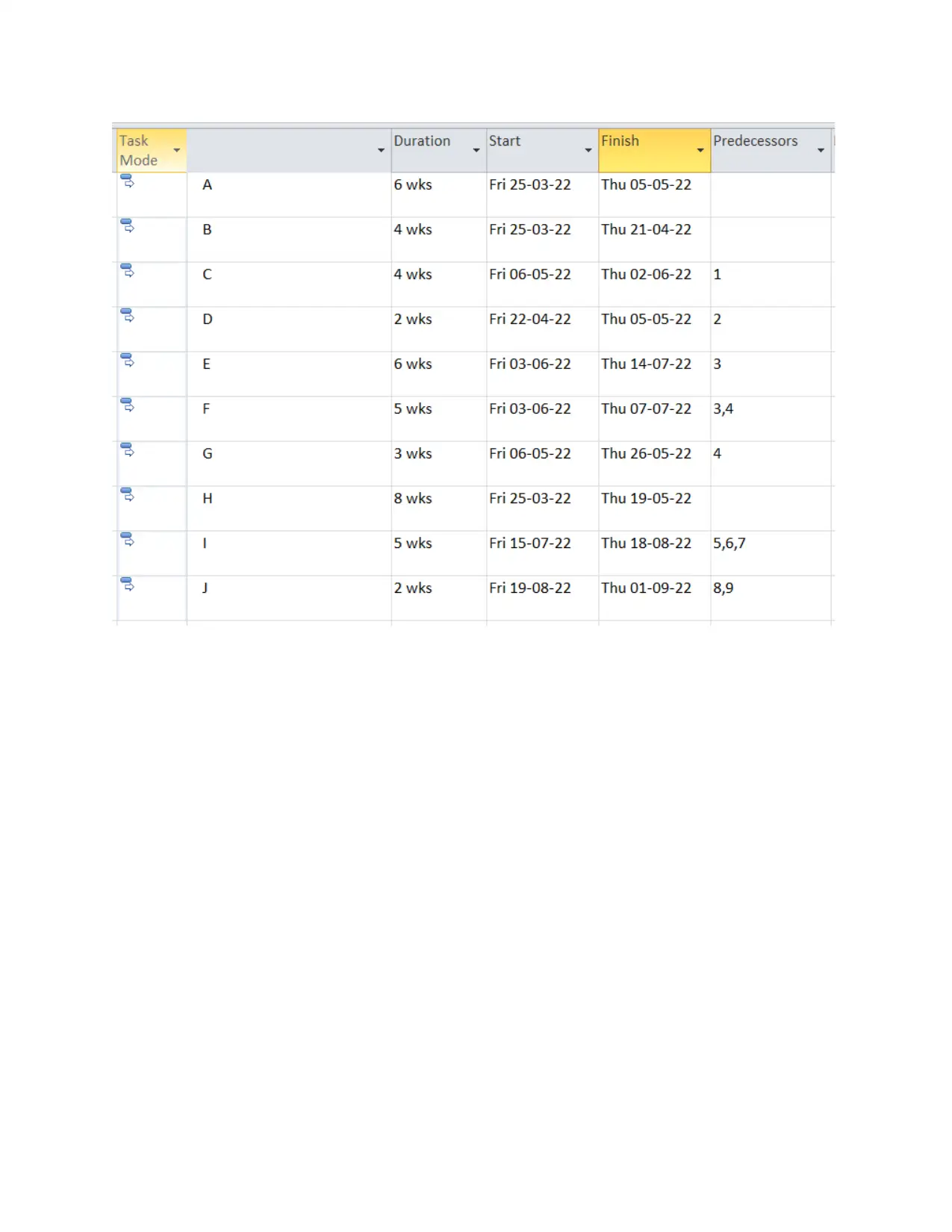

⊘ This is a preview!⊘
Do you want full access?
Subscribe today to unlock all pages.

Trusted by 1+ million students worldwide
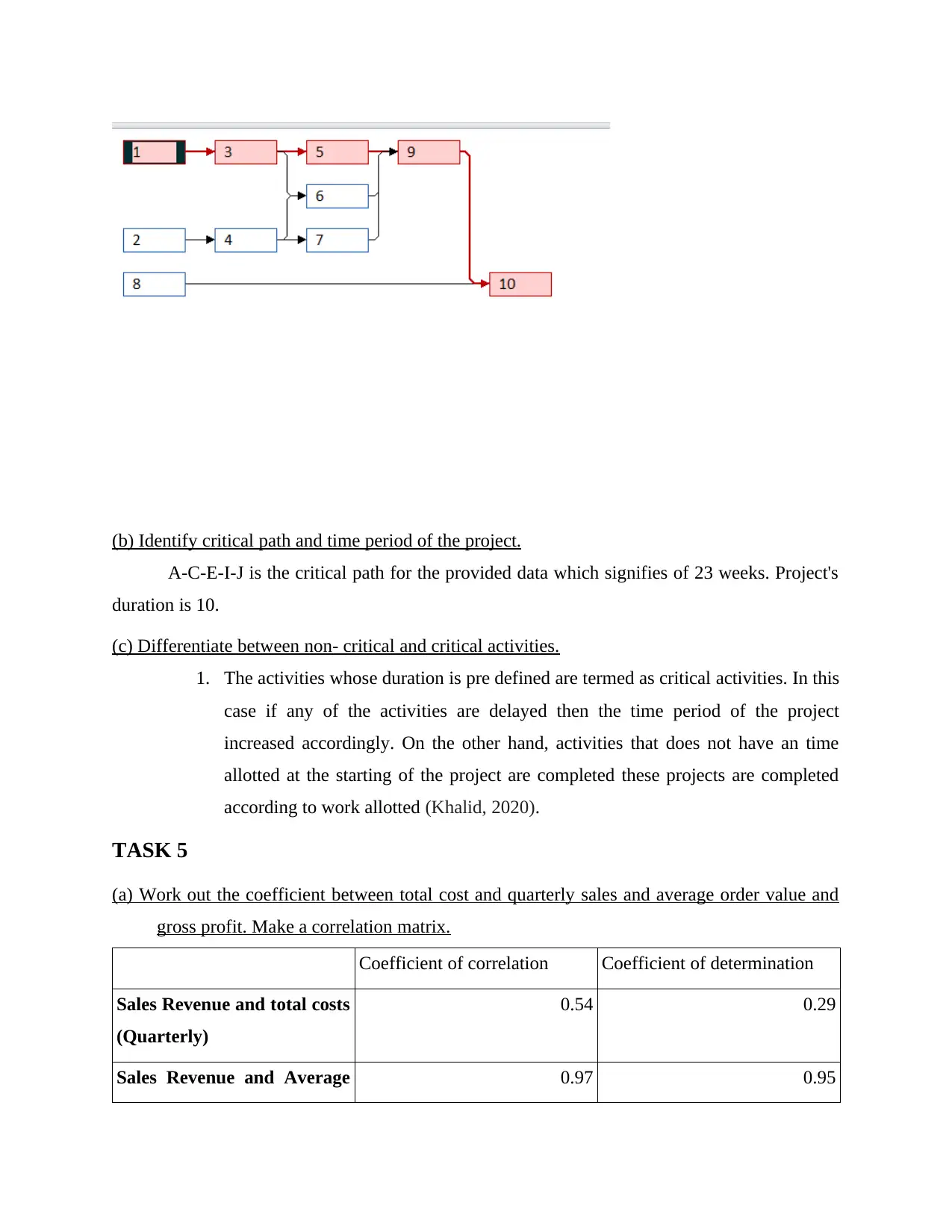
(b) Identify critical path and time period of the project.
A-C-E-I-J is the critical path for the provided data which signifies of 23 weeks. Project's
duration is 10.
(c) Differentiate between non- critical and critical activities.
1. The activities whose duration is pre defined are termed as critical activities. In this
case if any of the activities are delayed then the time period of the project
increased accordingly. On the other hand, activities that does not have an time
allotted at the starting of the project are completed these projects are completed
according to work allotted (Khalid, 2020).
TASK 5
(a) Work out the coefficient between total cost and quarterly sales and average order value and
gross profit. Make a correlation matrix.
Coefficient of correlation Coefficient of determination
Sales Revenue and total costs
(Quarterly)
0.54 0.29
Sales Revenue and Average 0.97 0.95
A-C-E-I-J is the critical path for the provided data which signifies of 23 weeks. Project's
duration is 10.
(c) Differentiate between non- critical and critical activities.
1. The activities whose duration is pre defined are termed as critical activities. In this
case if any of the activities are delayed then the time period of the project
increased accordingly. On the other hand, activities that does not have an time
allotted at the starting of the project are completed these projects are completed
according to work allotted (Khalid, 2020).
TASK 5
(a) Work out the coefficient between total cost and quarterly sales and average order value and
gross profit. Make a correlation matrix.
Coefficient of correlation Coefficient of determination
Sales Revenue and total costs
(Quarterly)
0.54 0.29
Sales Revenue and Average 0.97 0.95
Paraphrase This Document
Need a fresh take? Get an instant paraphrase of this document with our AI Paraphraser

order value (Quarterly)
Sales Revenue and gross
profit (Quarterly)
0.42 0.18
(b) Determine appropriate forecaster of sales and also explain the reason behind it.
The predictor that should be used to measure the coefficient of the quarterly sales with
0.97 and average order value. Highly co-related data is the highest correlation coefficient of the
following observations.
(c) Draw a scatter diagram and also show a trend of regression equation.
(d) Examine the determination and coefficient of correlation.
Coefficient of correlation demonstrates linkage among the factors linked to each other.
On the other hand, it determination depicts approx. 95.00% of the regression model of the data
provided (Montealegre and Iyengar, 2021).
(e) Examine the equation of regression and examine the value.
Regression mathematical represents is
Y = 0.03120X + 10.267
Sales Revenue and gross
profit (Quarterly)
0.42 0.18
(b) Determine appropriate forecaster of sales and also explain the reason behind it.
The predictor that should be used to measure the coefficient of the quarterly sales with
0.97 and average order value. Highly co-related data is the highest correlation coefficient of the
following observations.
(c) Draw a scatter diagram and also show a trend of regression equation.
(d) Examine the determination and coefficient of correlation.
Coefficient of correlation demonstrates linkage among the factors linked to each other.
On the other hand, it determination depicts approx. 95.00% of the regression model of the data
provided (Montealegre and Iyengar, 2021).
(e) Examine the equation of regression and examine the value.
Regression mathematical represents is
Y = 0.03120X + 10.267
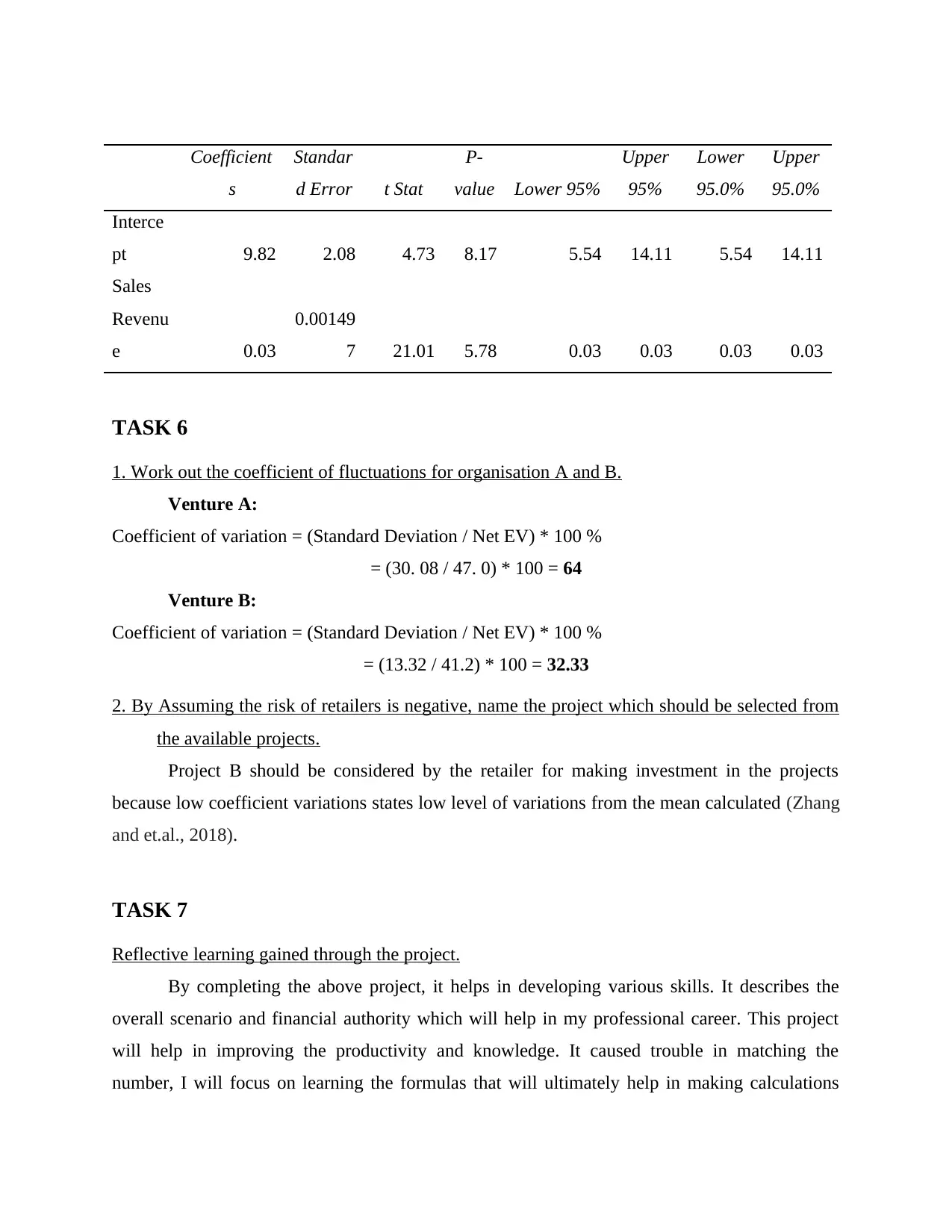
Coefficient
s
Standar
d Error t Stat
P-
value Lower 95%
Upper
95%
Lower
95.0%
Upper
95.0%
Interce
pt 9.82 2.08 4.73 8.17 5.54 14.11 5.54 14.11
Sales
Revenu
e 0.03
0.00149
7 21.01 5.78 0.03 0.03 0.03 0.03
TASK 6
1. Work out the coefficient of fluctuations for organisation A and B.
Venture A:
Coefficient of variation = (Standard Deviation / Net EV) * 100 %
= (30. 08 / 47. 0) * 100 = 64
Venture B:
Coefficient of variation = (Standard Deviation / Net EV) * 100 %
= (13.32 / 41.2) * 100 = 32.33
2. By Assuming the risk of retailers is negative, name the project which should be selected from
the available projects.
Project B should be considered by the retailer for making investment in the projects
because low coefficient variations states low level of variations from the mean calculated (Zhang
and et.al., 2018).
TASK 7
Reflective learning gained through the project.
By completing the above project, it helps in developing various skills. It describes the
overall scenario and financial authority which will help in my professional career. This project
will help in improving the productivity and knowledge. It caused trouble in matching the
number, I will focus on learning the formulas that will ultimately help in making calculations
s
Standar
d Error t Stat
P-
value Lower 95%
Upper
95%
Lower
95.0%
Upper
95.0%
Interce
pt 9.82 2.08 4.73 8.17 5.54 14.11 5.54 14.11
Sales
Revenu
e 0.03
0.00149
7 21.01 5.78 0.03 0.03 0.03 0.03
TASK 6
1. Work out the coefficient of fluctuations for organisation A and B.
Venture A:
Coefficient of variation = (Standard Deviation / Net EV) * 100 %
= (30. 08 / 47. 0) * 100 = 64
Venture B:
Coefficient of variation = (Standard Deviation / Net EV) * 100 %
= (13.32 / 41.2) * 100 = 32.33
2. By Assuming the risk of retailers is negative, name the project which should be selected from
the available projects.
Project B should be considered by the retailer for making investment in the projects
because low coefficient variations states low level of variations from the mean calculated (Zhang
and et.al., 2018).
TASK 7
Reflective learning gained through the project.
By completing the above project, it helps in developing various skills. It describes the
overall scenario and financial authority which will help in my professional career. This project
will help in improving the productivity and knowledge. It caused trouble in matching the
number, I will focus on learning the formulas that will ultimately help in making calculations
⊘ This is a preview!⊘
Do you want full access?
Subscribe today to unlock all pages.

Trusted by 1+ million students worldwide
1 out of 15
Related Documents
Your All-in-One AI-Powered Toolkit for Academic Success.
+13062052269
info@desklib.com
Available 24*7 on WhatsApp / Email
![[object Object]](/_next/static/media/star-bottom.7253800d.svg)
Unlock your academic potential
Copyright © 2020–2025 A2Z Services. All Rights Reserved. Developed and managed by ZUCOL.




